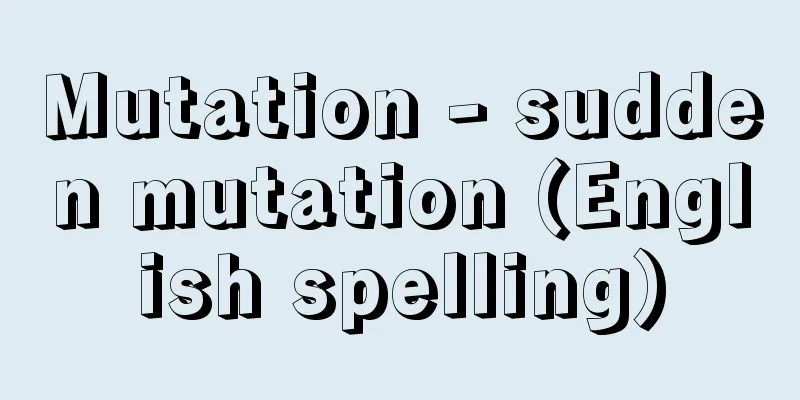Fascism - Fasizumu (English spelling) fascism English

|
A general term for a completely new type of political movement, political, economic, and social ideology, and political system that was authoritarian, dictatorial, and undemocratic in nature that appeared in many parts of the world over a period of approximately a quarter of a century, from the early 1920s immediately after World War I to 1945, when World War II ended. Fascism arose not only in Italy, Germany, and Japan, but also in Western and Eastern European countries such as Spain, Austria, Portugal, Romania, the former Yugoslavia, Hungary, Norway, Sweden, and the United Kingdom, as well as in South American countries such as Argentina, Chile, and Brazil. Among these countries, Italy, Germany, and Japan in particular are considered typical of fascist states, one reason being that powerful fascist regimes were established in those countries, and more importantly, these three countries, as one of the parties to World War II, made enemies of the so-called democratic camp, such as Britain, the United States, France, and the former Soviet Union, and fought against those countries. So why is this completely new type of movement, ideology, and system in world history called fascism? It is because this type of movement and ideology was first proposed by Mussolini of Italy, and the fascist system was established in Italy. The word fascio means "bundle" in Italian, and from there it came to be used as a word to mean "unity" or "solidarity." During World War I, syndicalists who wanted to participate in the war created an organization called "Revolutionary Action for Participating in the War Fasci," and after the war, Mussolini inherited this organization and renamed it "Combat Fasci," and in 1921 reorganized it into a political party called the "National Fascist Party." Since then, the word fascism has come to be widely used as a general term for dictatorial, non-parliamentary, and anti-communist movements, ideologies, and systems. [Hiroshi Tanaka] CauseThere are two possible reasons why fascism arose in Italy and Germany after World War I. One is the unprecedented economic crisis that followed the war and the resulting political crisis. The other is that after the war, a socialist state was born on Russian soil for the first time in world history, posing a threat to other countries. Italy and Germany formed modern nations two or three centuries later than Britain and France, and as they were late to join the race to carve up colonies, they naturally had weak economic foundations and were directly affected by the war, with serious problems such as unemployment, poverty, and inflation that became serious issues of life and death for people below the middle class, let alone the survival of the nation. As a political and ideological movement, the fascist movement put forward xenophobic nationalism, and economically, while condemning the advanced imperialist powers, it advocated a "revolution from below" in the name of achieving economic growth and stabilization of people's lives through strong state leadership, and it was centered around the middle class - theories of fascism that explain fascism in terms of the actions and ideology of the middle class stem from this - but it was also successful in incorporating the working class at large into its organization. This is something that would be hard to imagine without the extraordinary situation that occurred immediately after World War I. However, there was another way to resolve the crisis of the capitalist economy besides the path of fascism: the path of socialism. In fact, a socialist government led by Lenin was established in Russia as such a way. This encouraged the working class in various countries, and the socialist and labor movements rose worldwide. However, the leaders of the fascist movement severely suppressed it, believing that the intensification of class struggle would lead to national ruin. Fascism had a strong nationalistic character, preached anti-capitalism, anti-parliamentarism, and anti-democracy, as well as anti-socialism and anti-communism, and emphasized extreme statism through one-party dictatorship. This could be said to be due to the fear of the influence of Soviet socialism on their own country. In this way, we can see that fascism and socialism emerged as responses to the contradictions of capitalism and its general crisis that became particularly apparent after the end of the 19th century. However, the two states took completely different paths, with socialist states aiming to build a democratic society while fascist states sought to establish a totalitarian state system that denied individual freedom and democracy. This led to them being linked to imperialist aggression, and ultimately the two states confronted each other in World War II. [Hiroshi Tanaka] The nature of fascismIn Germany, the term Nazism was used rather than fascism, and in Japan the terms imperial fascism or totalitarianism were used; thus, although the term fascism is generally used in the three countries, the content of fascism is not necessarily the same; however, I will discuss the characteristics that they have in common. (1) State control and supervision of the economy Fascism was originally triggered by the crisis of the liberal capitalist economy, and so the idea of state control and supervision of the economy is strong in Fascism. Mussolini called this type of interventionism a mixed economy, and he devoted all his efforts to building such a political and economic system through a cooperative system between capital and labor. German political scientist Carl Schmitt defined the Fascist state as a totalitarian state (totalen Staat), and said that the characteristic of this state is that it is total in that "the state completely consumes society (economy)". However, since the end of the 19th century, capitalist states have also been trying to transform into welfare states, and the guidance and supervision of the state and government has been gradually strengthened, and in socialist states the economy is completely controlled under a planned economy. In this respect, the three political and economic systems appear to be similar at first glance. However, in the case of fascism, civil liberties and workers' rights are completely denied, and individual economic activity is subordinated to state interests, which makes the situation significantly different from that of capitalist and socialist states. (2) Fanatic nationalism The second characteristic of Fascism is its narrow-minded fanatic nationalism. Before the "March on Rome" in which the Fascist Party took power, Mussolini gave a speech in which he said that the concept of nation was superior to the Marxist concept of class. According to him, the state was the embodiment of the nation in a political system. He stated that the Fascist state was a "state formed and organized from below," called on the people to unite as a nation into a nation, and rejected the act of dividing the nation through class struggle. On the other hand, for the Germans, who were still divided into more than 300 territorial states at the time of the French Revolution, the formation of a modern unified nation like England and France was, so to speak, a national aspiration. It is for this reason that the concepts of a unified state, the Reich (Empire) and the Volk (Nation), became long-standing watchwords for the unification of the German nation. From this came the unique German concept of the nation, including "superiority of the Germanic race," "purity of blood," "blood and earth," and "anti-Semitism." According to Germans, the Jews were infiltrating countries around the world in an attempt to gain capitalist profits, while Jewish Marxism was preventing the unification of nations under the pretense of creating an international paradise on earth. The reason why the Nazi Party massacred the Jews and hated and severely oppressed the socialism and communism advocated by the Jewish Marx can only be understood by understanding the unique German concept of the nation. In this respect, the political function of the concept of ethnicity in Japan is different from that in Italy and Germany. In Japan, the nation has been considered to be composed of almost a single ethnic group, the Yamato people, since the dawn of history, and that this ethnic group has been unified with the Emperor at the top. This is why there is a lack of a movement of "revolution from below" in Japan. Then, from the period of "Enrich the country and strengthen the military" after the Meiji Restoration to the Fifteen-Year War, this concept of ethnicity was elevated to the idea of "Hakko Ichiu" (All the World in One Place), which holds that world rule by the descendants of the heavenly race is the supreme divine thing. This became the most important spiritual opportunity to unify the will of the people, and became the idea to justify the invasion of Asia and imperialist wars since the Meiji era. The idea of emphasizing a sense of ethnic mission was preached by Western Europeans who were carrying out imperialist colonial plundering since the 15th and 16th centuries, in the form of "the duty of the white man" and "the civilization of savages by Christian people." In the case of fascism, it can be said that narrow-minded nationalism was taken to an extreme form. (3) Anti-liberalism, anti-parliamentarism, anti-Marxism Unlike socialism, fascism does not reject capitalism itself, but it opposes its political ideology and political system. This may at first glance make it seem as though fascist states have an anti-capitalist character, but the true enemy of fascism is Marxism and socialist states. So why does fascism take an anti-liberal and anti-parliamentarist stance? According to Schmitt, this is because parliamentary democracy allows the existence of the Socialist Party and especially the Communist Party, which should be its enemy. In addition, the power of the working class has grown since the beginning of the 20th century, but the method of parliamentary democracy, which does not treat the enemy as an enemy but instead treats it as an opponent for debate, is in no way capable of opposing this powerful new social class. Therefore, now it is necessary to oppose and exterminate class enemies through one-party dictatorship rather than parliamentarism. In this way, fascism severely suppressed socialist movements and class struggle in both countries, which led to the complete denial of general democracy, such as civil liberties and parliamentary democracy, as can be seen in the application of the "Public Order Police Law" and the "Public Order Preservation Law" in Japan, and thus the totalitarian fascist state system was established. [Hiroshi Tanaka] The Establishment and Form of Fascism(1) Italian Fascism Italy is perhaps the most typical example of a fascist state. This is because Italy, in order to overcome the crisis of capitalism, appealed to the nationalism of the people and sought to gain popular support, and attempted to build a fascist system by closely cooperating and combining politics and economics. Immediately after taking power in 1922, Mussolini attempted to reorganize the capitalist state into a corporazione state by combining the professional unions of both capitalists and workers, and by using the corporazione method to determine measures for the overall regulation of economic relations and the unified order of production - this led to the Comintern's provision that viewed fascism as a new variant of bourgeois dictatorship by the monopoly capitalist class in the event of a capitalist crisis. At the top of this corporazione was the National Council of Corporaziones, and 22 corporaziones were established below it. Each corporazione supervised and guided the economic activities of its respective production sector. The "National Council" respected private initiative in production, but had the authority to ensure that it was harmonized with the interests of the entire economy and the state within the cooperative. This transformation into a cooperative state was completed in February 1934, when the cooperative was given legislative power. In this way, Mussolini combined the construction of a powerful nation that he claimed had overcome the contradictions of capitalism and the threat of communism with his dream of expanding into the world. By doing so, he strengthened solidarity with German Nazism, which had come to power in January 1933. After invading Ethiopia, withdrawing from the League of Nations, and signing the Tripartite Pact with Japan, Germany, and Italy, Italy entered World War II as a member of the Axis powers. (2) Nazism in Germany After the failure of the Munich Putsch in 1923, the Nazi Party pursued a path to gaining legal power by increasing its seats in parliament. Under the banner of restoring the former glory of the German people that had been lost after the defeat in the war, it rallied a large number of unemployed military personnel and a wide range of small and medium-sized producers who were in unstable situations, and also succeeded in attracting a part of the working class with the misleading name of the party, "National Socialist German Workers' Party." The emergence of the Great Depression that began in 1929 gave impetus to the expansion of the Nazi Party's influence. In the election of 1932, the party finally became the largest party, but the ruling class, fearing its fanatical political beliefs, hesitated to hand over power to Hitler. However, the ruling class, which had lost the ability to resolve the serious political and economic crises of the 1930s, preferred fascism to the threat of communism, and finally handed power to Hitler in January 1933. At this point, the ruling class seemed optimistic that they would be able to control the Nazi Party. However, Chancellor Hitler made effective use of the emergency powers of the President stipulated in Article 48 of the Weimar Constitution to suppress trade union and party activities, and on March 24, 1933, he enacted the "Law for the Elimination of Dangers to the Race and the Reich," instantly seizing all power into his own hands. This law caused the collapse of the Weimar Republic, and thereafter Hitler established a totalitarian dictatorship in which his orders and will were unconditionally supported by "cheering" and "acclamations," and he began preparations for war, aiming to lead the way to World War II. (3) Japanese Fascism As Japanese fascism is often called, it was based on the belief in the Emperor that had been built up over many years under the Meiji Constitution, and it formed an authoritarian national system "from above" by the military and bureaucrats, and carried out the Fifteen Years' War. This differs from the cases of Italy and Germany, which organized the people with the aim of revolution "from below" and gained fascist governments. Some argue that Japan was not a fascist state on this point. However, even in Japan during this period, there was the strengthening of state supervision and control of the economy, the preaching of aggressive nationalism based on the idea of "Hakko Ichiu," the indoctrination of anti-liberal, anti-democratic, anti-parliamentary, and anti-socialist ideologies, and, domestically, the enactment of the National General Mobilization Law (1938) and the formation of the Imperial Rule Assistance Association and the Greater Japan Industrial Patriotic Association (1940). Looking at the international actions taken, such as the invasion of Manchuria (1931), withdrawal from the League of Nations (1933), and the signing of the Tripartite Pact between Japan, Germany, and Italy (1940), there is no doubt that Japan was a fascist state. (4) Other Fascist Regimes In the 1920s and 1930s, fascist regimes and movements appeared one after another in various countries other than the three major countries. For example, the Horthy regime in Hungary in 1920, the Piłsudski regime in Poland in 1928, the Salazar regime in Portugal in 1933, the Dollfuss regime in Austria in 1934, the Franco regime in Spain in 1936, and the Antonescu regime in Romania in 1940. During World War II, fascist regimes were established in Chile, Brazil, Argentina, and other countries. In addition, although they did not gain power, fascist movements such as the British Union of Fascists led by Mosley in the UK, the American Nazi Party in the US, and the Action Française led by Maurras in France, as well as fascist movements in Canada, Belgium, the Netherlands, Norway, Finland, India, and other countries also appeared. Most of these regimes and movements disappeared after World War II, but some, such as the Franco regime, survived for a while even after the war. [Hiroshi Tanaka] The problem of postwar fascismWith the defeat of Japan, Germany and Italy in World War II, fascist states disappeared from the face of the earth for the time being. However, since the fascist movement and ideology included a challenge and denial of democracy, it cannot be said that the danger of fascism reappearing has completely disappeared today. After the war, the term totalitarianism seems to be used more than fascism, but for example, in the midst of the intensifying conflict between the United States and the Soviet Union in the early 1950s, the United States criticized the Stalin regime as totalitarian, while the former Soviet Union attacked the American McCarthyism, which suppressed freedom of thought and belief at the time, as totalitarian. Considering that World War II was caused by Japan, Germany and Italy, three countries with weak concepts of human rights and freedom and extremely insufficient establishment of democratic political systems, doesn't it teach us how to prevent the reappearance of fascism today? [Hiroshi Tanaka] "The Fascist System" by Isao Yamazaki (1972, Ochanomizu Shobo)" ▽ "Trends in Contemporary Fascism Theory" by Sadao Yamaguchi (1978, Yuhikaku)" ▽ "State and Society in the Age of Fascism" edited by the Institute of Social Science, University of Tokyo, 8 volumes (1978-80, University of Tokyo Press)" ▽ "Carl Schmitt" by Hiroshi Tanaka (1992, Miraisha) Source: Shogakukan Encyclopedia Nipponica About Encyclopedia Nipponica Information | Legend |
|
第一次世界大戦直後の1920年代初頭から第二次大戦終結時点の1945年までの約4半世紀間にわたり、世界の多くの地域に一時期出現した、まったく新しいタイプの強権的、独裁的、非民主的な性格をもった政治運動、政治・経済・社会思想、政治体制の総称。 ファシズムは、イタリア、ドイツ、日本をはじめとして、スペイン、オーストリア、ポルトガル、ルーマニア、旧ユーゴスラビア、ハンガリー、ノルウェー、スウェーデン、イギリスなどの西・東欧諸国、またアルゼンチン、チリ、ブラジルなどの南米諸国においても発生した。これらの国々のうちで、とくにイタリア、ドイツ、日本の3国がファシズム国家の典型とされるのは、一つには、その地において強力なファシズム政権が確立されたこと、さらにより重要なことは、これら日独伊3国が、第二次大戦の一方の当事国として、イギリス、アメリカ、フランス、旧ソ連などのいわゆる民主主義陣営を敵に回して、それらの国々と戦ったからである。 では、この世界史上まったく新しいタイプの運動・思想・体制をなぜファシズムとよぶのか。それは、このような運動・思想が最初にイタリアのムッソリーニによって提唱され、かつイタリアにおいてファシズム体制が確立されたからである。ファッショfascioという語は、イタリア語の「束」を意味し、そこから転じて、「団結」「結束」を表す語として用いられるようになった。第一次大戦中、参戦派のサンジカリストたちが「革命的参戦行動ファッシ」という名称の組織をつくり、戦後、ムッソリーニがこの組織を継承して「戦闘ファッシ」とし、1921年には「国民ファシスタ党」という政党に改組した。これ以後、ファシズムということばが、独裁的・非議会主義的・反共主義的な運動・思想・体制の総称として広く一般に用いられるようになった。 [田中 浩] 発生因ファシズムが第一次大戦後のイタリアやドイツにおいて発生した理由は二つ考えられる。一つは、大戦後の未曽有(みぞう)の経済的危機とそれによる政治的危機の出現という問題である。もう一つは、大戦後、世界史上初めてロシアの地に社会主義国家が誕生し、各国に脅威を与えたことである。イギリスやフランスよりも2、3世紀遅れて近代国家を形成したイタリアやドイツは、植民地分割競争に乗りおくれたため当然にその経済的基盤が弱く、大戦の影響をまともに受け、深刻な失業、貧困、インフレ問題などは、国家的存立はもとより、中産階級以下の人々にとって深刻な死活問題ともなった。ファシズム運動が、政治運動、思想運動としては排外主義的なナショナリズムを前面に掲げ、経済的には、先進帝国主義列強の非を鳴らしつつ国家の強力なリーダーシップによる経済成長と国民生活の安定を図ると称して「下からの革命」を唱え、中産階級を主体に――ファシズムを中産階級の行動や思想から説明するファシズム論はこれに起因する――広く労働者階級までをも組織に組み入れることに成功したのは、第一次大戦直後の異常事態を抜きにしてはとうてい考えられないであろう。 ところで、資本主義経済の危機を解決する方法としては、ファシズムの道のほかに社会主義への道があった。事実、そのようなものとしてロシアにおいてはレーニンの指導する社会主義政権が樹立された。このことは、各国の労働者階級を勇気づけ、世界的に社会主義運動や労働運動が高揚する。しかし、ファシズム運動の指導者たちは、階級闘争の激化は国家的破滅につながるものとしてこれを厳しく弾圧した。ファシズムが民族主義的性格を色濃くもち、反資本主義、反議会主義、反民主主義を唱えるとともに、反社会主義、反共産主義を掲げて、一党独裁による極端な国家主義(ステイティズム)を強調したのは、ひとえにソ連社会主義の自国への影響を恐れたためであったといえよう。このようにみると、ファシズムと社会主義は、19世紀末以降とくに顕在化した資本主義の矛盾とその全般的危機に対する対応策として出現したものであることがわかる。しかし、この両者はまったく違った道を歩み、社会主義国家は民主主義社会の建設を目ざし、ファシズム国家は、個人の自由や民主主義を否定する全体主義的な国家体制の確立を追求し、そのことは帝国主義的侵略主義と結び付き、結局、この両者は第二次大戦において対決することになる。 [田中 浩] ファシズムの性格ドイツでは、ファシズムという語よりもナチズムという語が用いられ、日本では天皇制ファシズムあるいは全体主義という語が用いられたように、ひと口にファシズムといっても、3国におけるファシズムの内容はかならずしも同じではないが、共通する性格について述べる。 (1)国家による経済の統制・監督 ファシズム運動は、そもそも自由主義的な資本主義経済の危機を契機に発生したこともあって、ファシズムにおいては国家による経済の統制・監督という思想が強い。ムッソリーニは、このような干渉主義を混合経済とよび、そのような政治・経済体制を資本と労働の協同体方式によって建設することに全力を注いでいる。またドイツの政治学者カール・シュミットは、ファシズム国家を全体主義国家totalen Staatと規定し、この国家の特質は「国家が社会(経済)を呑(の)み尽くす」点で全体的であると述べている。もっとも19世紀末以来、資本主義国家においても福祉国家への転換が図られ、国家や政府の指導・監督がしだいに強化されつつあったし、社会主義国家においては計画経済の下に経済は完全にコントロールされている。この点については、三つの政治・経済体制は一見似通ってみえる。しかし、ファシズム国家の場合には、市民的自由や労働者の権利はまったく否定され、個人の経済活動も国家利益に従属させられているという点で、資本主義国家や社会主義国家の場合とその様相を大きく異にしているといえる。 (2)狂信的民族主義 ファシズムの第二の特質は、その偏狭な狂信的民族主義にある。ムッソリーニは、ファシスタ党が政権をとる「ローマへの進軍」を前にして、民族の概念がマルクス主義的な階級の概念よりも優位しているとの演説を行った。彼によれば、国家とは民族が政治制度において具現化されたものであった。彼は、ファシズム国家は「下から形成・組織された国家」であると述べ、国民に対して国家への民族的統一を呼びかけ、階級闘争による国家分裂の行動を否定している。他方、フランス革命当時にあってもなお300を超える領邦国家に分裂していたドイツ人にとっては、イギリスやフランスのような近代的統一国家の形成は、いわば民族の悲願ともいうべきものであった。統一国家=帝国(ライヒ)Reichと民族(フォルク)Volkという概念がドイツ民族統一のための長年にわたる合いことばとなったのはこの理由による。ここから「ゲルマン民族の優越性」「血の純潔」「血と大地」「反ユダヤ主義」というドイツ特有の民族概念が生まれた。ドイツ人によれば、ユダヤ人は世界中の国々に潜入して資本主義的利益を獲得するために狂奔し、他方では、ユダヤ的マルクス主義は、インターナショナルな楽園をこの地上に創出すると称して民族の統一を妨げている、というわけである。ナチ党がユダヤ人を大量虐殺し、またユダヤ人マルクスの唱えた社会主義や共産主義を憎悪しこれを厳しく弾圧したのは、ドイツ人特有の民族概念を知ることによって初めて解明できる。 この点、日本における民族概念の政治的機能は、イタリアやドイツの場合と異なる。日本では、国家は有史以来、大和(やまと)民族というほとんど単一の民族で構成され、その民族が天皇を頂点として統合されてきたと考えられていた。日本において、「下からの革命」という運動が欠如しているのはそのためである。そして、こうした民族概念は、明治維新以後の「富国強兵策」の時代から十五年戦争期にかけて、天孫民族による世界統治こそ神聖至上なりとする「八紘一宇(はっこういちう)」の思想にまで高められ、それは国民意志を統合する最重要な精神的契機となり、明治以来のアジア侵略や帝国主義戦争を正当化する思想となったのである。もっとも民族的使命感を強調する思想は、15、16世紀以来、帝国主義的植民地略奪を遂行しつつあった西欧人の間でも、「白人の責務」「キリスト教国民による未開人の教化」という形で唱えられたが、ファシズムの場合には、偏狭な民族主義が極端な形にまで進んだものといえよう。 (3)反自由主義・反議会主義・反マルクス主義 ファシズムは社会主義と異なり、資本主義そのものは否定しないが、その政治思想や政治制度には反対する。そのことが一見ファシズム国家は反資本主義的性格をもつと思われがちだが、ファシズムの真の敵はマルクス主義、社会主義国家である。ではなぜ、ファシズムは反自由主義、反議会主義の立場をとるのか。それは、シュミットによれば、議会制民主主義は、本来敵であるべき社会党やとくに共産党の存在を許しているためだ、という。また20世紀に入って労働者階級の力が強大となったが、敵を敵として扱わず、討論相手にしているような議会制民主主義のやり方では、とうていこの強大な新しい社会階級に敵対できない、したがって、いまや議会主義ではなく一党独裁によって階級敵に対抗し、これを絶滅しなければならない、というわけである。こうして、ファシズムは、いずれの国においても社会主義運動や階級闘争を厳しく弾圧したが、そのことは、日本の「治安警察法」や「治安維持法」の適用にもみられるように、市民的自由や議会制民主主義などの一般的民主主義までも全面的に否定することとなり、ここに、全体主義的なファシズム国家体制が確立されたのである。 [田中 浩] ファシズムの成立と形態(1)イタリアのファシズム ファシズム国家という点でもっとも典型的なのはイタリアの場合であろう。なぜなら、そこでは、資本主義の危機を乗り越えるために、国民のナショナリズムに訴えて大衆的支持を得ることを目ざし、政治と経済の緊密な協同・結合を図ってファシズム体制をつくりあげようと試みているからである。ムッソリーニは、1922年の政権獲得後ただちに、資本家と労働者双方の職業組合を結合し、経済的諸関係の全体的規制と生産的統一秩序のための方策を決定できる協同体corporazione方式により、資本主義国家を協同体国家へと改編しよう――ここに、ファシズムを、資本主義の危機に際しての独占資本家層による新しいブルジョア独裁の変種とみるコミンテルン規定が生まれた――と試みている。この協同体では、頂点に「協同体全国協議会」があり、その下部に22の協同体が設けられている。各協同体はそれぞれの生産部門の経済活動を監督・指導する。「全国協議会」は、生産の私的イニシアティブは尊重しつつ、それが協同体において全経済の利益、国家の利益と調和するように図る権限を有する。この協同体国家への改編は34年2月に協同体に立法権が与えられることによって完成した。こうしてムッソリーニは、資本主義の矛盾とコミュニズムからの脅威を克服したと称する強大な国家建設と世界進出の夢を結合させることによって、33年1月に政権を獲得したドイツ・ナチズムと連帯を強めつつ、エチオピア侵略、国際連盟脱退、日独伊三国同盟の締結を経て、枢軸国の一員として第二次大戦に参戦するのである。 (2)ドイツのナチズム ナチ党は、1923年のミュンヘンでの一揆(いっき)に失敗して以後、議席拡大による合法的な権力獲得の道を追求し、敗戦によって失われたかつてのドイツ民族の栄光を回復するという旗印を掲げ、大量の失業軍人や不安定な状況に置かれていた広範な中・小生産者層を結集し、また「国民社会主義ドイツ労働者党」という紛らわしい党名によって労働者階級の一部をも引き付けることに成功した。29年に始まった世界大恐慌の出現は、ナチ党の党勢拡大に弾みをつけた。32年の選挙ではついに第一党の地位についたが、その狂信的政治信条を恐れた支配層は、ヒトラーに政権を移譲することをためらった。しかし、30年代の深刻な政治的・経済的危機を解決する能力を失った支配層は、コミュニズムの脅威よりもファシズムをよしとして、ついに33年1月にヒトラーに政権を渡した。この時点では支配層は、ナチ党をコントロールできるものと楽観視していたようである。しかし、首相ヒトラーは、ワイマール憲法第48条に規定された大統領の非常大権を有効に活用して組合運動や政党活動を抑圧し、33年3月24日には「民族と帝国の危難排除のための法律」を制定してたちまちいっさいの権限をその手中に収めた。この法律によりワイマール共和国は崩壊し、以後、ヒトラーは、「歓呼」と「喝采(かっさい)」という方式によって彼の命令と意志を無条件に支持する全体主義的独裁体制を確立し、第二次大戦への道を目ざして戦争準備を始めることになる。 (3)日本のファシズム 日本のファシズムは「天皇制ファシズム」とよばれるように、明治憲法体制の下で長年かけてつくりあげてきた国民の天皇信仰を背景に、軍部・官僚による「上から」の強権的国家体制を形成して十五年戦争を遂行したという点で、「下から」の革命を目ざして国民を組織し、ファシズム政権を獲得したイタリアやドイツの場合と様相を異にする。この点をめぐって日本はファシズム国家ではなかったと主張する者もいる。しかし、この時期の日本でも国家による経済の監督・統制の強化、「八紘一宇」の観念による侵略的民族主義の高唱、反自由主義・反民主主義・反議会主義・反社会主義などの思想教化、さらには国内的には国家総動員法の制定(1938)、大政翼賛会・大日本産業報国会の結成(1940)などを通じて機構的に天皇制ファシズム体制が確立され、国際的には満州侵略(1931)、国際連盟からの脱退(1933)、日独伊三国同盟の締結(1940)などを断行した経過をみると、日本がファシズム国家であったことは間違いない。 (4)その他のファッショ体制 1920、30年代には、主要3国以外にも、ファシスト政権やファシズム運動が各国で相次いで出現している。たとえば1920年にはハンガリーにホルティ政権、28年にはポーランドにピウスツキ政権、33年にはポルトガルにサラザール政権、34年にはオーストリアにドルフス政権、36年にはスペインにフランコ政権、40年にはルーマニアにアントネスク政権、また第二次大戦中には、チリ、ブラジル、アルゼンチンなどにファシスト政権が誕生した。そのほか、政権獲得までには至らなかったが、イギリスのモズリー一派の「イギリス・ファシスト同盟」、アメリカの「アメリカ・ナチス党」、フランスのモーラスらの「アクシオン・フランセーズ」などのファシズム運動が、またカナダ、ベルギー、オランダ、ノルウェー、フィンランド、インドなどでもファシズム運動が出現したのである。こうした政権や運動は、第二次大戦後ほとんどその姿を消したが、フランコ政権のように戦後に至ってもなおしばらく生き残った政権もあった。 [田中 浩] 戦後のファシズム問題第二次大戦での日独伊3国の敗北によりファシズム国家はひとまずこの地上から姿を消した。しかし、ファシズムの運動や思想が民主主義への挑戦・否定を含むものであったということからすれば、今日においてファシズム再現の危険性がまったくなくなったとはいえない。戦後はファシズムという用語よりも全体主義ということばが用いられているようだが、たとえば1950年代前半における米ソの対立激化のなかで、アメリカはスターリン体制を全体主義として非難し、他方旧ソ連は、当時、思想・信条の自由を抑圧していたアメリカのマッカーシズムを全体主義として攻撃した。第二次大戦が、人権と自由の観念が希薄であり、民主的な政治制度の確立がきわめて不十分であった日独伊3国によって引き起こされたことを考えれば、それは、今日の時点においてファシズムの再現を防ぐ方法は何かをわれわれに教えているといえないだろうか。 [田中 浩] 『山崎功著『ファシズム体制』(1972・御茶の水書房)』▽『山口定著『現代ファシズム論の諸潮流』(1978・有斐閣)』▽『東京大学社会科学研究所編『ファシズム期の国家と社会』全8冊(1978~80・東京大学出版会)』▽『田中浩著『カール・シュミット』(1992・未来社)』 出典 小学館 日本大百科全書(ニッポニカ)日本大百科全書(ニッポニカ)について 情報 | 凡例 |
>>: Fadeev, Aleksandr Aleksandrovich
Recommend
Ancient Records of Great Japan - Dainihonkokiroku
This is a series of historical documents on Japan...
Selection - Senshu
Before sowing, seeds are selected and prepared to...
Fissure (English spelling) fissure; rhagade
This is what is commonly known as cracks or chappe...
Catecholamines
…A tumor arising from the chromaffin cells of the...
Okuramae Discount - Okuramae Discount
…The Kuramae market price was the wholesale price...
Orchis graminifolia (Butterfly Orchid)
A perennial plant of the orchid family. It is foun...
Haliplidae
…They emerge from the water and pupate in the soi...
Lindemann, CLF (English spelling) LindemannCLF
...With the development of electronic computers, ...
Home medicines - kateijobyaku
It is a home remedy that is convenient to have on...
Zäsy, U. (English spelling) ZasyU
…German jurist. His German name was Ulrich Zäsy. ...
Tarudama [Hot Spring] - Tarudama
A hot spring located on the southwestern slope of ...
Imaisurugi - Imaisurugi
The centre of Tonami county, Ecchu province (Toyam...
Siraf (English spelling)
…They traveled as far as India and China. At that...
Tomoe-shaped copperware
A bronze ornament seen from the Yayoi to Kofun pe...
Miyake [town] - Miyake
A town in Shiki County, Nara Prefecture. It occupi...









